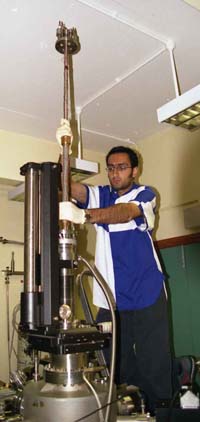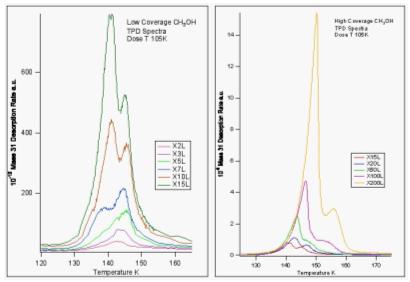








The experiments in the surface science lab are concerned with investigating the formation of small molecules, other than H2, on simulated cosmic dust grains under “interstellar” conditions. |
Experiment to study the formation of simple interstellar molecules on cosmic dust grain analogues |
 |
The aim of the experiments that are currently underway in the surface science lab is to use infrared spectroscopy and temperature programmed desorption to study the chemistry of heterogeneous processes that occur on the surface of analogues of dust grains in space. Many different molecules, including CH3OH, NH3 and H2O, have been observed in interstellar space. However, the quantities of molecules observed are far greater than can be explained by gas phase reactions alone. Heterogeneous processes, whereby species such as CO, N and O undergo sequential hydrogenation, are therefore thought to be fundamental to the formation of these molecules. These heterogeneous reaction mechanisms have not been studied to date and are therefore not well understood.
|
The apparatus that will be used for these experiments consists of a UHV chamber equipped with a closed cycle helium refrigerator. This will allow the experiments to be performed in conditions which mimic those in interstellar space i.e. low pressure and temperatures of the order of 10-20 K. An atom source is coupled to the UHV chamber to allow the dosing of H, or O, atoms onto a surface which is a suitable analogue of a cosmic dust grain. Reflection absorption infrared spectroscopy (RAIRS) is the main technique that is used to study these reactions. RAIRS is an infrared technique that can be used to probe the species present on a surface. This technique allows us to identify the products, and intermediates, of the reactions. This is achieved by observing the vibrational frequencies of intermolecular bonds of molecules adsorbed on the surface. Temperature programmed desorption (TPD) is also used as a probe of the species desorbing from the surface. Current experiments are concerned with investigating the adsorption of methanol, water and ammonia on the surface of highly oriented pyrolytic graphite (HOPG). We are also looking at the adsorption and desorption of mixed overlayers of water and methanol on the HOPG surface. If we are to understand the formation of these species on the surface, it is first necessary to look at the adsorption and desorption of these molecules so that a fingerprint of the species in the infrared or TPD can be obtained. The figure below shows a series of TPD spectra for the adsorption of methanol on HOPG at 100 K. |
 |
This research has been reviewed recently in the RSC's Chemistry World and the article can be accessed here. The research of the surface science lab was featured in an exhibit at the Royal Society Summer Exhibition 2004. Amandeep Bolina and Angela Wolff are currently working in the lab, under the supervision of Dr Wendy Brown. |